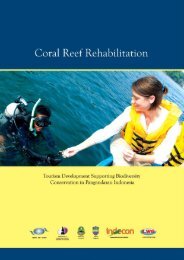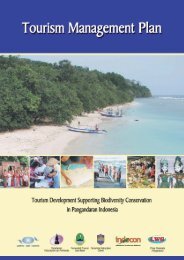Compilation <strong>and</strong> <strong>Review</strong> <strong>of</strong> <strong>Laws</strong> <strong>and</strong> <strong>Regulation</strong>s in IndonesiaCompilation <strong>and</strong> <strong>Review</strong> <strong>of</strong> <strong>Laws</strong> <strong>and</strong> <strong>Regulation</strong>s in Indonesia• Using an environmentally technology• Prepare <strong>and</strong> disseminate information onenvironment, <strong>and</strong>• Grant awards to people with merit <strong>and</strong>achievement in the management <strong>of</strong> coastal areas<strong>and</strong> small isl<strong>and</strong>s.While, in the field <strong>of</strong> tourism, Government<strong>Regulation</strong> No. 67 <strong>of</strong> 1997 on the implementation <strong>of</strong>tourism, education is more limited to the education<strong>of</strong> tourism human resources though pr<strong>of</strong>essionaleducation <strong>and</strong> training in tourism, at the elementary,secondary <strong>and</strong> tertiary levels as part <strong>of</strong> the nationaleducation <strong>and</strong> pr<strong>of</strong>essional training, <strong>and</strong> trainingin the field <strong>of</strong> tourism includes st<strong>and</strong>ardization,accreditation <strong>and</strong> certification (Chapter 111).Development policies for Culture <strong>and</strong> TourismDevelopment (Presidential Instruction No. 16 <strong>of</strong>2005) give instruction to the Minister <strong>of</strong> NationalEducation to :a. Accelerate the inclusion <strong>of</strong> national history,personality development, high morale <strong>and</strong>multicultural values in education.b. Increase appreciation <strong>of</strong> aesthetics <strong>and</strong> arts.c. Improve tourism activities among the youthduring school holidays <strong>and</strong> as extra curricularactivities.d. Improve the quality <strong>of</strong> education related totourismAt the moment, tourism education as a wholeis still focused on the training <strong>of</strong> tourism humanresources. However, The Minister <strong>of</strong> Culture <strong>and</strong>Tourism Decree No. KM64/HK.201/MKP/04 onGuidelines on the development <strong>of</strong> local tourismmentioned that in addition to the improvement <strong>and</strong>capacity building on <strong>of</strong> hotel management skilledworkers, restaurants, travel agencies, <strong>and</strong> guides;capacity building on foreign language skills amongthe stakeholders; the preparation <strong>and</strong> readiness <strong>of</strong>hosts; also include the improvement <strong>of</strong> technicalskills in tourism management which theoreticallycomprises <strong>of</strong> planning, implementation, monitoring<strong>and</strong> maintenance <strong>of</strong> the various sites.Although the laws have targeted a governmentallocation <strong>of</strong> 20 % for the education budget, thishas not yet been readily implemented by central<strong>and</strong> local governments. The attainment <strong>of</strong> the 20% proportion will be done in stages. The CiamisRegency is one <strong>of</strong> the most advanced regions toallocate development funds in its APBD (annualregional budget) <strong>and</strong> this is estimated to be 13%<strong>of</strong> the total budget. A higher level <strong>of</strong> educationwould eventually lead to a higher awareness inthe community to be involved in the process <strong>of</strong>planning, <strong>and</strong> attempts for an integrated planning<strong>and</strong> implementation process between tourism <strong>and</strong>biodiversity.Table 2. List <strong>of</strong> Strategic Issues <strong>and</strong> their ImportanceIssue Explanation/sub issues Scale10The absence <strong>of</strong> a “code <strong>of</strong> Conduct” for operators <strong>and</strong> a “code <strong>of</strong> ethics” for visitors as an effort to organize visitors <strong>and</strong> toreduce destructive actionsAs a result, there is no mechanism to organize visitors in particular because the operators still give importance to set upmechanism to gain income only.Low human resources capacity within the operators, both the Dinas Pariwisata, as well as Perhutani which is theimplementer <strong>of</strong> TWA <strong>and</strong> the BKSDA as implementer <strong>of</strong> CA.This condition is reflected in the activities <strong>and</strong> the services provided by the operatorsDual operations in the TWA. Perhutani as the concession holder has not carried out its responsibilities to invest in the TWAarea <strong>and</strong> only collects entrance tickets . This prompted BKSA also as implementer to also collect tickets in particular becausePerhutani has not made any investment. As result at the moment there are two operators.No innovative mechanism has been created to solve the problem <strong>of</strong> haphazard garbage litter by visitors1. Weak Implementation <strong>of</strong> tourism inthe Pang<strong>and</strong>aran area <strong>and</strong> thenature Tourism area.10No action taken by operators towards street hawkers/vendors setting up their business in unauthorized areas.No action taken towards trespassers; hawkers; those collecting fire-wood <strong>and</strong> fishermen who enter the TWA <strong>and</strong>conservation sitesNo action taken towards community members or tourists who carry out destructive activities such as collecting live marinebiota, feeding animals resulting behavior changing, littering garbage.No action is taken towards staffs on duty who do not give entrance tickets to visitors.2. Weak law enforcement by operatorstowards violations <strong>of</strong> regulationboth in the Pang<strong>and</strong>aran tourismarea as well as in TWA <strong>and</strong> CA9Both the community <strong>and</strong> members <strong>of</strong> pr<strong>of</strong>essional groups have not been involved at all in the planning for the development<strong>of</strong> the tourism area, they were involved only in the end process at the socialization <strong>of</strong> the plan designed by experts.The community has not been adequately involved in the implementation by the Pang<strong>and</strong>aran Tourism Office.3. The Community <strong>and</strong> members <strong>of</strong>pr<strong>of</strong>essional groups are not includedin the planning <strong>and</strong> implementation<strong>of</strong> tourism activities.10There is little information <strong>and</strong> inadequate socialization in the community on the benefits <strong>of</strong> conservation <strong>and</strong> the importance<strong>of</strong> preserving natural resources <strong>and</strong> biodiversityThe community is still <strong>of</strong> the opinion that natural resources exploited now will not result in their decline, for example –marine biota were collected for souvenirs everyday are perceived to be always be available.4. Low awareness <strong>of</strong> the community<strong>and</strong> visitors on the importance <strong>of</strong>natural resources conservation.9There is little information <strong>and</strong> socialization on cleanliness <strong>and</strong> environmental health.The community still considers cleanliness <strong>and</strong> environmental health as merely the responsibility <strong>of</strong> the operators <strong>and</strong> thegovernment rather than as an individual responsibilityInadequate education on cleanliness <strong>and</strong> environmental health at the household level.These interlinked conditions resulted in the habit <strong>of</strong> littering garbage by both community embers <strong>and</strong> visitors..5. Low awareness in the community<strong>and</strong> by visitors on the importancecleanliness <strong>and</strong> environmentalhealth8Activities that reduce the population <strong>of</strong> fauna are still going on such as firewood gathering, collecting marine biota <strong>and</strong>tourism activities in the core conservation area.Diminishing grazing l<strong>and</strong> <strong>and</strong> grass fields which was precipitated by the eruption <strong>of</strong> Mt. Galunggung in 1994 which destroyedvast surface vegetations.Level <strong>of</strong> sedimentation <strong>and</strong> abrasion resulting in a habitat changes.6. Habitat degradation <strong>and</strong> decliningpopulation <strong>of</strong> fauna such asbuffaloes <strong>and</strong> bulls10The feeding <strong>of</strong> wild animals changed their behavior resulting in dependence to visitorsCollecting marine biota for souvenirs.Entering core conservation area not meant for tourism7. Negative impact <strong>of</strong> tourism onbiodiversity9Destruction <strong>of</strong> coral reefs as a result <strong>of</strong> frequent visits <strong>and</strong> tourist boats.The uncontrolled increase <strong>of</strong> accommodation <strong>and</strong> the increase <strong>of</strong> population in the Pang<strong>and</strong>aran area affects present <strong>and</strong>future clean water supply.Decrease in quantity <strong>and</strong> quality <strong>of</strong> clean water supply.The dry season which is also the high tourist season affects water supply.8. Availability <strong>and</strong> reliability <strong>of</strong> watersupply~ 20 ~~ 21 ~
Compilation <strong>and</strong> <strong>Review</strong> <strong>of</strong> <strong>Laws</strong> <strong>and</strong> <strong>Regulation</strong>s in IndonesiaCompilation <strong>and</strong> <strong>Review</strong> <strong>of</strong> <strong>Laws</strong> <strong>and</strong> <strong>Regulation</strong>s in IndonesiaIssue Explanation/sub issues Scale7The benefits if the tourism sector has not reached the community leaving outside the tourism destination area.Core tourism business is controlled by entrepreneurs from outside the area while the community is only involved in smallscale business (last economic chain).The presence <strong>of</strong> tourism is closely linked to only a limited economic sectors (fishery) <strong>and</strong> has not been used to develop9. Benefits <strong>of</strong> the tourism sector havenot been properly distributed67several other economic sectors (coconut, agriculture, etc.)10. Poor partnership among economic No network among the existing pr<strong>of</strong>essions based economic groups.players.No common underst<strong>and</strong>ing or agreement between players in economic sector in conducting bussiness <strong>and</strong> increasing pr<strong>of</strong>it,both in production, distribution, processing, <strong>and</strong> marketing activities.Overlap <strong>of</strong> oerational sites by economic players in the tourism area.Even though there are two dominant ethnic groups in Pang<strong>and</strong>aran, conflicts mostly occur on the issues <strong>of</strong> economiccompetition, not on ethnic or religion conflict.11. Lost Traditions Some traditions are in the process <strong>of</strong> extinction due to acculturation between local people with other cultures, not only atthe tourism context, but at family level due to TV programs, migration, or other Media.The lost <strong>of</strong> traditions can be both by rational choice <strong>of</strong> the local community members <strong>and</strong> forces <strong>of</strong> external factors, such ascontroversy on Cirengganis ritual. In Pang<strong>and</strong>aran, most traditions are lost by rational choice <strong>of</strong> people after consideringwhether those traditions are still useful or effective t in their social life, or other new ways are found which are moreefficient, such as between Wayang, Rengkong, <strong>and</strong> Ronggeng compare with modern Dangdut singing or solo keyboardattraction in wedding partiesLost traditions can also happen because the actors have no capacity <strong>and</strong> power to sustain them.412. Social Gap Social gap based on l<strong>and</strong> ownership exists in Pang<strong>and</strong>aran, especially between the plantation entrepreneurs <strong>and</strong> small-scalefarmers <strong>and</strong> no-l<strong>and</strong> farmers.6Prostitutes utilize facilities in Pang<strong>and</strong>aran for their operation, <strong>and</strong> thereby affecting the perception <strong>of</strong> Pang<strong>and</strong>aran as aarea for prostitution.13. Negative social impact <strong>of</strong>development including tourismdevelopment.68Tour guides do not provide educational content <strong>and</strong> there are no interpretation boards in the tourist area.Existing tours do not provide enough educational contentThere is no accurate <strong>and</strong> correct information prepared to be used as a reference by tour guides.The capacity <strong>of</strong> tour guides is till limited <strong>and</strong> they do not have interpretation skills yet.14. The image <strong>of</strong> Pang<strong>and</strong>aran as amass tourism area15. Minimal education content inexisting tourism activities7The abundance <strong>of</strong> natural resources <strong>and</strong> potential for cultural activities in Pang<strong>and</strong>aran has not been optimized for thedevelopment <strong>of</strong> tourism in Pang<strong>and</strong>aran.Tourism in Pang<strong>and</strong>aran seems to be static <strong>and</strong> still depends on nature as attraction. This situation has been going on forover 10 yearsTourism characterized by seeking a “New Experience” is at the moment gaining interest, but has not been utilized as anopportunity in Pang<strong>and</strong>aran.16. Inadequate diversification intourism products in Pang<strong>and</strong>aran.10The activity <strong>and</strong> development <strong>of</strong> tourism in the Pang<strong>and</strong>aran area, both outside the designated area or inside have not paidattention the conservation <strong>of</strong> natural resources. On the other h<strong>and</strong>, conservation activities have also not been linked totourism activities. Actually tourism has a huge potential to increase awareness <strong>of</strong> community <strong>and</strong> visitors on the importance<strong>of</strong> conservation <strong>of</strong> natural recourses <strong>and</strong> biodiversity.17. No linkage between tourismactivities <strong>and</strong> conservation3.2 Legal aspects related to the degradation <strong>of</strong> theenvironment in Pang<strong>and</strong>aran.3.2.1 Weak implementation <strong>of</strong> tourism both in thePang<strong>and</strong>aran area as well as in the natureTourism area.a. <strong>Review</strong> <strong>of</strong> laws <strong>and</strong> regulations <strong>and</strong>/ orrestrictive clauses related to the weakimplementation <strong>of</strong> tourism in the Pang<strong>and</strong>aran<strong>and</strong> Nature Tourism areas.Implementation – planning, implementation,monitoring <strong>and</strong> evaluation, feedback <strong>and</strong> recoveryare important considerations in the operation <strong>of</strong>tourism <strong>and</strong> involve many components – tourismattraction, accessibility, service etc. Policies <strong>and</strong>regulations were established to regulate thesevarious important tourism components. Through thePresidential Instruction No. 16 <strong>of</strong> 2005 on policiesto develop culture <strong>and</strong> tourism, the Head <strong>of</strong> Statehas instructed the Minister for Internal Affairs toamongst others to:• Encourage provincial, regional <strong>and</strong> municipalgovernments to plan tourism development,especially to improve the quality <strong>of</strong> touristattraction sites, service readiness , comfort <strong>and</strong>security.• Encourage provincial, regional <strong>and</strong> municipalgovernments to protect <strong>and</strong> maintain historicalbuildings <strong>and</strong> archeological sites.While governors <strong>and</strong> Regents amongst other arerequired to:• Compile a Master Plan for regional tourismdevelopment (product development, marketing<strong>and</strong> facilities <strong>and</strong> services/human resources);• Conduct supervision <strong>and</strong> control <strong>of</strong> environmentsdegradation.• Develop information on investment opportunitiesin the field <strong>of</strong> culture <strong>and</strong> tourism• Increase <strong>of</strong> tourism through the Seven points toachieve admiration (Sapta Pesona), safety, order,cleanliness, comfort, beauty, friendliness <strong>and</strong>impressiveness.• Implement a system for the management <strong>of</strong>tourism locations <strong>and</strong> the preparation <strong>of</strong> basicinfrastructure.• Develop tourism attractions in areas <strong>of</strong> tourismmovements <strong>and</strong> around the cities.Tourism in Pang<strong>and</strong>aran is implemented byindividual tourism operators, coordination ingeneral is attempted through networks <strong>of</strong> business<strong>and</strong> pr<strong>of</strong>essional associations, <strong>and</strong> is an informal<strong>and</strong> personal inter-pr<strong>of</strong>essional <strong>and</strong> businesscoordination related with the business interest<strong>and</strong> pr<strong>of</strong>ession <strong>of</strong> each member. It is therefore, notsolid, <strong>and</strong> comprehensive but general, leaving outenvironmental issues in the area.The guidance for the implementation <strong>of</strong> tourism isthe responsibility <strong>of</strong> the Ciamis local department<strong>of</strong> Culture <strong>and</strong> Tourism. There is an UPTD inPang<strong>and</strong>aran which seems to have the limitedauthority to organize the collection <strong>of</strong> entrancetickets to the area, but has no function or hasnot carried out leadership <strong>and</strong> coordinationamong all parties, which is a crucial factor in theimplementation <strong>of</strong> tourism involving so manygroups/components.In addition to this tourism UPTD, there is the villagegovernment responsible for village development. Thevillage has taken the initiative to organize tourismin the village <strong>and</strong> to increase the village economyby developing tourism such as in Cantigi <strong>and</strong> KarangBenda. However, this initiative in general stops atthe planning stage <strong>and</strong> cannot be realized. As it is, amuch bigger effort <strong>and</strong> initiative is needed than that<strong>of</strong> the village government to realize these proposals.As in the case with the Pang<strong>and</strong>aran area, in generalimplementation is a big concern. In Chapter 9 <strong>of</strong>RR18/1994 on the Operation <strong>of</strong> Nature Tourism inproduction zones in national parks, dense forest,<strong>and</strong> nature tourism parks, it is spelled out that theoperators <strong>of</strong> nature tourism have the rights to :• Manage the tourism facility according to thebusiness type granted in the business approval.• Receive compensation from visitors using theservices provided.• As the implementer <strong>of</strong> the nature tourism, theoperator is obliged to :~ 22 ~~ 23 ~




